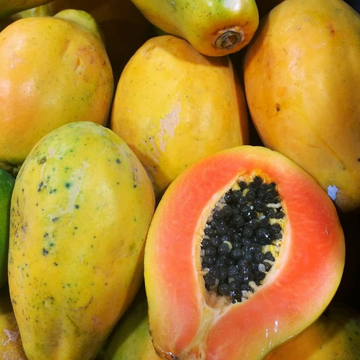Buy Papayas(پپیتا) - 1kg
Best Offers: 1kg
Quantity:
This product is currently out of stock, but you can place an order through WhatsApp. We'll try our best to make it available for you if possible
The papaya is a small, sparsely branched tree, usually with a single stem growing from 5 to 10 m (16 to 33 ft) tall, with spirally arranged leaves confined to the top of the trunk. The lower trunk is conspicuously scarred where leaves and fruit were borne. The leaves are large, 50–70 cm (20–28 in) in diameter, deeply palmately lobed, with seven lobes. All plant parts contain latex in articulated laticifers...
Benefits :
benefits, including protection against heart disease, reduced inflammation, aid in digestion, and boosting your immune system.
Uses of papaya:
Fresh Consumption: Papaya can be eaten fresh, often enjoyed as a snack or breakfast fruit.
Salads: Papaya is a popular ingredient in fruit salads and can also be used in savory salads.
Smoothies and Juices: Papaya can be blended into smoothies or juiced for a refreshing drink.
Desserts: Papaya is used in various desserts such as papaya pudding, sorbet, and fruit parfaits.
Cooking: Unripe green papaya is used in cooking, particularly in Asian cuisines, for dishes like green papaya salad and curries.
Chutneys and Salsas: Papaya can be used to make chutneys, salsas, and relishes to accompany savory dishes.
Nutrition value:
- Calories: 43
- Total Fat: 0.3 g
- Saturated Fat: 0.1 g
- Cholesterol: 0 mg
- Sodium: 8 mg
- Potassium: 182 mg
- Total Carbohydrate: 11 g
- Dietary Fiber: 1.7 g
- Sugar: 7 g
- Protein: 0.5 g
- Vitamin C: 62% DV






















